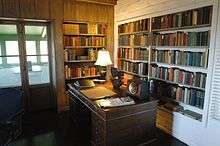Eugene O'Neill National Historic Site
|
Tao House | |
|
Tao House in summer | |
  | |
| Location | Kuss Road, Danville, California |
|---|---|
| Coordinates | 37°49′28″N 122°1′47″W / 37.82444°N 122.02972°WCoordinates: 37°49′28″N 122°1′47″W / 37.82444°N 122.02972°W |
| Area | 158.6 acres (64.2 ha) |
| Built | 1937 |
| Architect | Frederick Confer |
| Architectural style | Monterey Colonial |
| Visitation | 3,652 (2005) |
| Website | Eugene O'Neill National Historic Site |
| NRHP Reference # | 71000137[1] |
| Significant dates | |
| Added to NRHP | May 6, 1971[1] |
| Designated NHL | July 17, 1971[2] |
| Designated NHS | October 12, 1976 |
The Eugene O'Neill National Historic Site, located in Danville, California, preserves Tao House, the Monterey Colonial hillside home of America's only Nobel Prize-winning playwright, Eugene O'Neill.
History
Eugene O'Neill had won the Nobel Prize for Literature in 1936, and used the prize money to build what he named Tao House above Danville.[3] O'Neill and his wife lived in the home from 1937 to 1944.[4] At this home, O'Neill wrote his final plays: The Iceman Cometh, Long Day's Journey Into Night, Hughie, and A Moon for the Misbegotten.[3] Due to a degenerative condition in his hand, he was unable to complete another play after 1943.[5]

O'Neill and his wife, actress Carlotta Monterey, showed their interest in Asian art, decor, and thought in preparing the home.[3] The ceilings were dark blue to mimic the sky with dark wood floors representing the earth, as well as Noh masks, Chinese guardian statues, and Chinese lacquerware furnishings throughout the interior.[6] Outside, Carlotta installed a garden in a zigzag pattern which Chinese tradition indicated would keep away evil spirits.[7] They also planted several trees, including pine, almond, and redwood.[6] The O'Neills moved to Boston after World War II.[8]
The house was saved from demolition in the early 1970s. Several women formed the Eugene O’Neill Foundation, including president Darlene Blair and executive vice president Lois Sizoo, in order to raise money to buy Tao House, which had been named a National Landmark in 1971.[9] They did so through several fundraising projects, including benefit performances of Eugene O’Neill’s play Hughie featuring Jason Robards. Through their efforts, Tao House was declared a National Historic Landmark in 1971,[2] a National Historic Site in 1976, and passed into the management of the National Park Service in 1980.
Archive
The Foundation maintains an archive of Eugene O'Neill-related material at Tao House (including photographs, playbills, manuscripts, posters, and O'Neill's original phonograph record collection) and sponsors events such as productions of O'Neill plays, staged in the adjacent barn.
Visiting the house
The National Park Service does not publish the address of the property, but it is widely known that it is located near Kuss Road in Danville. A locked gate prevents unauthorized vehicles from reaching the site. The Site occupies 13 acres (5.3 ha) accessible via car only by private road, so advance reservations are required to visit. Private vehicles are not allowed. Transportation to the site is provided by a twice-daily free shuttle from Danville at 10am and noon on Wednesdays to Sundays and also at 2pm on Saturdays. Reservations are required except on Saturdays when tours are self-guided.[10]
Trails from Las Trampas Regional Wilderness also lead to the site. Reservations are also recommended for those arriving for a tour via horseback or on foot.
See also
References
- 1 2 National Park Service (2010-07-09). "National Register Information System". National Register of Historic Places. National Park Service.
- 1 2 "Tao House". National Historic Landmarks Quioklinks. National Park Service. Retrieved 19 March 2012.
- 1 2 3 McKinney, John. California's National Parks: A Day Hiker's Guide. Berkeley, CA: Wilderness Press, 2005: 135. ISBN 0-89997-387-6
- ↑ Camble, Robert S. (March 23, 1973). "Eugene O'Neill House" (pdf). National Register of Historic Places - Inventory Nomination Form. National Park Service. Retrieved 18 May 2012.
- ↑ McKinney, John. California's National Parks: A Day Hiker's Guide. Berkeley, CA: Wilderness Press, 2005: 136–137. ISBN 0-89997-387-6
- 1 2 Boeck, Raynell. Peaceful Places San Francisco: 110 Tranquil Sites in the City and the Greater Bay Area. Menasha Ridge Press, 2010: 61. ISBN 978-0-89732-718-3
- ↑ McKinney, John. California's National Parks: A Day Hiker's Guide. Berkeley, CA: Wilderness Press, 2005: 135–136. ISBN 0-89997-387-6
- ↑ McKinney, John. California's National Parks: A Day Hiker's Guide. Berkeley, CA: Wilderness Press, 2005: 137. ISBN 0-89997-387-6
- ↑ Kaufman, Polly Welts. National Parks and the Woman's Voice: A History. The University of Mexico Press, 2006: 215. ISBN 978-0-8263-3994-2
- ↑ Reservation page for Tao House
External links
| Wikimedia Commons has media related to Tao House. |
- NPS: official Eugene O'Neill Historic Site website
- Eugene O'Neill Foundation: website
- "Eugene O'Neill House" (pdf). Photographs. National Park Service. Retrieved 18 May 2012.
.jpg)


